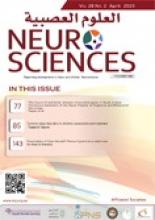To the Editor
We have read with interest the article by AlTahan et al1 on a 25 years-old female who was diagnosed with sensori-motor Guillain-Barre syndrome (GBS) with onset 14 days after a mild SARS-CoV-2 infection.1 Based on the predominance of sensory disturbances and reduced amplitudes of compound muscle action potentials (CMAPs) and of sensory nerve action potentials (SNAPs), GBS was sub-classified as acute, motor, sensory, and axonal neuropathy (AMSAN).1 The patient profited significantly from intravenous immunoglobulins (IVIGs) and gabapentin (GBT).1 The study is excellent but has limitations that raise concerns and should be discussed.
A limitation of the study is that no magnetic resonance imaging of the cranial nerve roots with contrast medium was carried out.1 Because the patient complained about pain in the face and the tongue, it is crucial that nerve roots of cranial nerves V, IX, and X were investigated. In GBS with cranial nerve involvement, thickening or enhancement of cranial nerve roots has been reported.2 To rule out Bickerstaff encephalitis, a rare subtype of GBS,3 and other types of encephalitis, it is crucial that also an MRI of the brain with contrast medium is carried out.
Another limitation of the study is that cerebrospinal fluid (CSF) examinations were not comprehensive. There is no mention of oligoclonal bands (OCBs), which can be positive in SARS-CoV-2 associated GBS. To rule out infectious radiculitis it is crucial to examine the CSF for bacterial, viral, fungal, and parasitic infection by appropriate tests. There is also no mention of cytokine and chemokines levels in the CFS which are usually elevated in SARS-CoV-2 associated GBS.4 Distal latencies were markedly prolonged in the median nerve (8.6 ms), ulnar nerve (5.5 ms), peroneal nerve (10 ms).1 Surprisingly, F-wave latencies were reported as normal.1 One would expect prolonged F-wave latencies if distal latencies are markedly prolonged. How do the authors explain this discrepancy?
There is no mention whether distal quadruparesis resolved in addition to sensory disturbances upon IVIGs. Because resolution of facial, tongue and limb sensory disturbances could be also due to GBT, it is crucial to know if also muscle weakness completely resolved. Improvement of neurophysiological parameters not necessarily coincides with clinical improvement of motor deficits.
Because AMSAN is commonly complicated by autonomic disturbances, we should know whether the index patient was tested for autonomic dysfunction or if she complained about typical autonomic disturbance, such as oversensitivity to light, dry eyes or mouth, arrhythmias, constipation or diarrhoea, urogenital dysfunction, or hypo- or hyperhidrosis.
Overall, the interesting study has limitations that put the results and their interpretation into perspective. Clarifying these limitations would strengthen the conclusions and could improve the study. Patients with SARS-CoV-2 related GBS require extensive diagnostic work-up to rule out differential diagnoses and to monitor the effect of treatment.
Reply from the Author
We appreciate immensely Drs. Finsterer & Mehri’s interest in our recently published case report of a patient with post-COVID-19 GBS and electrophysiological features of reversible conduction failure.1 We have the following responses to their comments.
First, MRI of cranial nerve roots, in this case, is unlikely to show significant changes because the brunt of pathology was in the distal parts of the axons of both cranial and spinal nerves as demonstrated on NCS. Further, MRI in GBS is not a routine test and is only indicated to exclude a relevant differential diagnosis.5 MRI was reported to be positive in only 30% of patients with Bickerstaff brainstem encephalitis (BBE).6 Furthermore, none of the classical clinical features of The BBE (altered level of consciousness, ophthalmoplegia, ataxia, and pyramidal signs)7 was present in this patient, therefore BBE was not considered in the differential diagnosis.
Second, Anti-gangliosides antibodies would have been important in view of their association with reversible conduction failure. The same applies to CSF cytokines and chemokines levels, however, this patient was first managed in a private clinic where investigations are dictated by clinical rather than academic indications due to insurance-financial reasons! Viral and bacterial CSF studies were negative. Oligoclonal bands can be positive in GBS in general and has no specific relevance to post-COVID-19 GBS cases.
Third, F-wave is recorded by providing 10-15 supramaximal stimulations, and the minimal latency is used for interpretation. Sometimes the prolongation in F-wave minimal latency is proportional to the prolongation in the distal motor latency (DML). For example, in our patient, the median DML was 8.6 ms (prolonged by 4.1 ms above the upper limit of normal 4.5 ms). In the absence of proximal demyelination, distal slowing may not be reflected on F-wave, which has an upper limit of normal of 33 ms. Most young individuals have F wave minimal latency of 24 – 27 ms, if one adds 4.1 ms, it remains below the ULN. In fact, the normal F-wave in our patient is suggestive of the absence of proximal demyelination and is consistent with the normal strength of the patient’s proximal muscles.
The patient did not complain of any symptom related to autonomic dysfunction that merits more specific autonomic function tests. She had a normal electrocardiogram, and her blood pressure and pulse rate were normal on regular measurements. On follow up the patient recovered fully including her mild distal weakness.
- Copyright: © Neurosciences
Neurosciences is an Open Access journal and articles published are distributed under the terms of the Creative Commons Attribution-NonCommercial License (CC BY-NC). Readers may copy, distribute, and display the work for non-commercial purposes with the proper citation of the original work.






